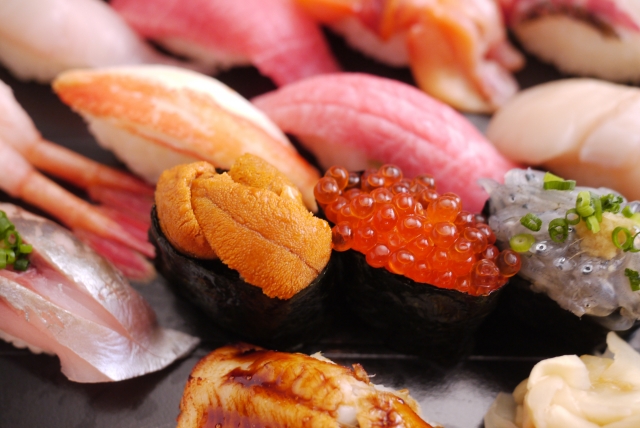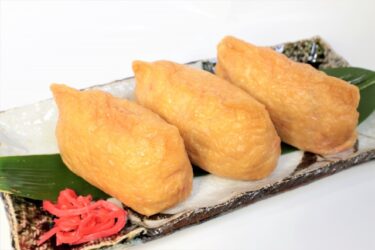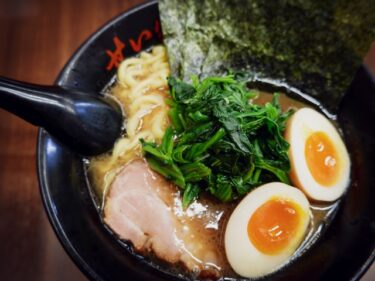Sushi is a traditional Japanese dish that combines rice and seafood.
There are various types of sushi such as hand-pressed sushi with raw seafood, rolled sushi with egg and vegetable, and inarizushi using fried tofu and sushi rice.
Some sushi does not use raw fish, and some sushi is vegetarian.
What is Sushi and can I eat it?
Materials of Sushi
Sushi-meshi (Sushi rice) Rice, rice vinegar, sugar, and salt
Ingredients Seafood (tuna, yellowtail, snapper, salmon, squid, grilled eel, shrimp, octopus, clam, fish roe, sea urchin, and so on), vegetable (cucumber, pickled radish), grilled egg, etc.
Nigirizushi (hand-pressed sushi)
| Gluten-free※ | Low-gluten | Wheat-free※ | Low FODMAPs | |
| with Egg ★ |
| Restaurant | Food supermarket |
Makizushi (rolled sushi)

| Gluten-free※ | Low-gluten | Wheat-free※ | Low FODMAPs | |
| with Egg ★ | for Vegetarian★ |
| Restaurant | Food Market | Convenience store |
Inarizushi

| Gluten-free※ | Wheat-free※ | Low FODMAPs | ||
| for Vegetarian |
| Food Market | Convenience store |
It is a kind of sushi made by stuffing rice in a sweet and spicy deep-fried tofu which was simmmered with soy sauce, mir[…]
★ Depending for ingredients.
Many types of Sushi other than Nigiri
There are many types of sushi, so here we will explain about “Nigirizushi”, “Makizushi” and “Inarizushi” that can be eaten anywhere.
Nigirizushi (hand-pressed sushi) consists of a bite-sized sushi rice and the ingredients on top of the sushi rice. Seafood is the most commonly used ingredient, and tuna, yellowtail, snapper, salmon, squid, and shrimp are popular. Shellfish, octopus, sea urchin, and roasted fish are also often used. Raw beef is sometimes used in a modern luxury sushi restaurant.
There is “wasabi” between the ingredients and the rice. Wasabi is grated root of a plant and has a strong spiciness like mustard. If you don’t like wasabi, you can order a sushi craft man to “remove wasabi.” At rotating sushi and food supermarkets, wasabi comes in a small bag, so you can put it on yourself when you eat it.
When you eat sushi, add a little soy sauce. Soy sauce is a seasoning unique to Japan made by fermenting soybeans, wheat and salt. During the fermentation process, proteins are broken down into amino acids, which are umami ingredients. Therefore, although wheat is used, soy sauce can be eaten by people who are allergic to wheat. If you have celiac disease, make your own judgment.
You may find pink sour vegetables. This is called “Gari”, which is ginger soaked in sweet and sour vinegar. If you eat Gari after eating a piece of sushi, your mouth will be refreshed and you will be able to eat the next sushi deliciously.
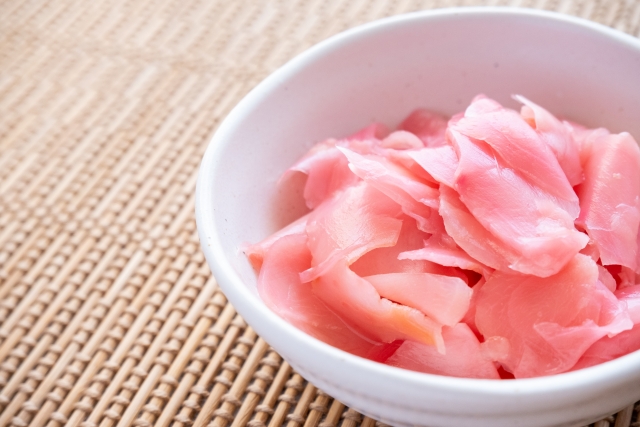
Makizushi is also popular in Japan. It is made by placing sushi rice and ingredients on seaweed, rolling it into a cylinder, and cutting it into bite-sized pieces. Fried egg, dried gourd shavings, and shiitake mushrooms are usually used as ingredients, but there are also those with cucumber, or pickled radish, or tuna. Eat with a little soy sauce.
Inarizushi is a pouch of fried tofu typically filled with sushi rice alone. The fried tofu is seasoned with soy sauce, and sugar, so you can eat it without adding anything. The sushi rice may contain finely boiled carrot, shiitake mushrooms, and sesame seeds.
“Inari” means the Shinto Inari shrine. Fox was the messenger of the god and the fox’s favorite food was fried tofu. Therefore sushi with fried tofu was called Inarizushi. The head of Inari Shrine is Fushimi Inari Taisha Shrine in Kyoto. It was established 1300 years ago and is famous for a thousand of torii gates.
Try to eat !
How much ?
- Conveyor belt sushi shop
$1~3 per 2 pieces (one plate) - Food market or convenience store
$3~8 per 10 pieces (for one person) - Sushi restaurant
$30~80 per one person

Where can I eat Sushi?
Conveyor belt sushi shop
There are 22,000 shops in Japan, with national chains, regional chains, and privately owned stores. The prices are cheaper at national chains. See the end for details.
Food market or convenience store
You can usually get it at the delicatessen section of food supermarkets or the lunch box section of convenience stores.
Sushi Restaurant
At a sushi restaurant, you should order what you want to eat at your seat, but if you don’t understand Japanese, it’s difficult to order. In addition, some restaurants do not have a menu, and you may order by looking at the ingredients in the glass case at the counter. It is not recommended except for sushi restaurant that are frequently used by foreigners.
Precautions when eating Sushi
Gluten-free
It doesn’t meet the requirements to be labeled as gluten-free, but the food contains very little gluten. People with wheat allergies can eat with confidence. If you have celiac disease, make your own judgment. We recommend a conveyor belt sushi restaurant where you can order after carefully seeing what is used for sushi.
Vegetarian
Some sushi does not use seafood, but there are few types. If you want to enjoy foods, it’s more rational to buy sushi rolls and Inari sushi at a food supermarket than to go to a sushi restaurant.
Japanese writer’s comment for a conveyor belt sushi shop
If you want to eat sushi in Japan, a conveyor belt sushi shop is definitely recommended. It’s because you can choose easily and the system is interesting.

Conveyor belt sushi shops are becoming more automated. When you first enter the shop, please enter the number of people and your desired seat (whether a counter seat or a box seat) in the reception machine. If there are vacant seats, a paper with the seat number printed on it will come out, so take it and sit in the designated seat. If it is full, the call number is printed on it, so please wait on the bench at the entrance.
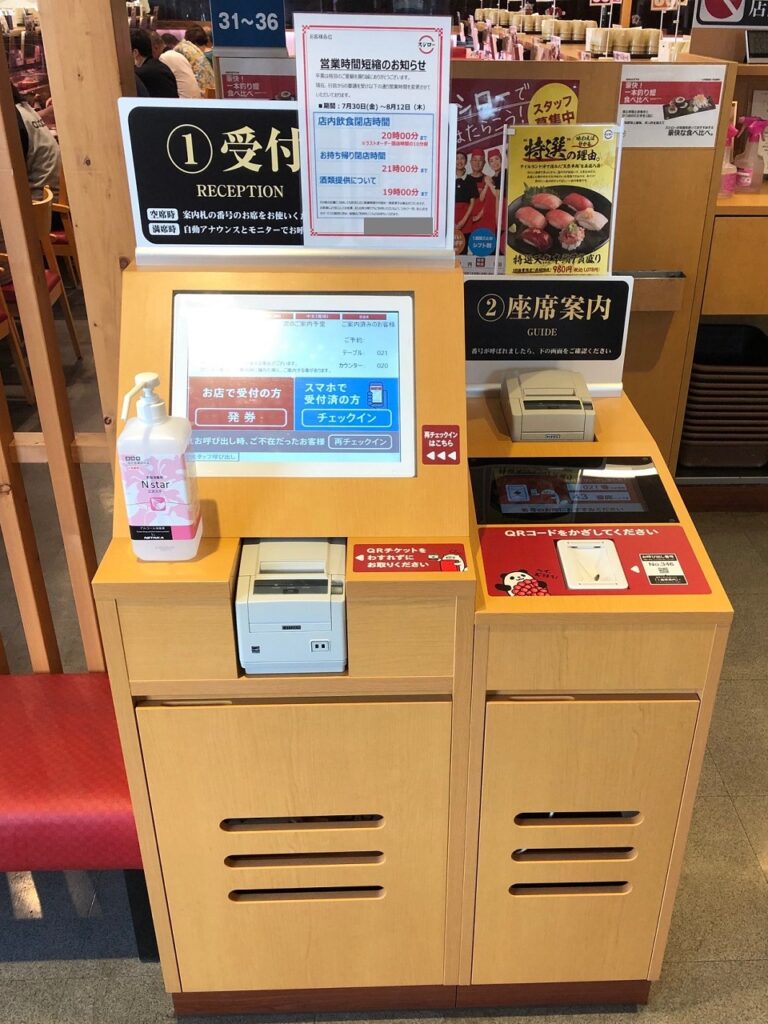
When you get to your seat, prepare your own tea. Pour green tea from a pot of green tea powder and pour hot water from the faucet on the table. Hot water comes out when you press the faucet. You can take the sushi that is flowing on the conveyor, or you can order it from your tablet. You can switch the display to English.

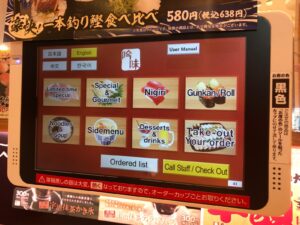
Some of the sushi on the conveyor is ordered by others, so please be careful about the display of the plate When you take it, be sure to take it with the plate. Put the vacant dishes on your table.
In a conveyor belt sushi shop, the number of plates is used for accounting. The price is determined by the color of the plate, and the cheapest plate is usually around $1.


When you finish eating, press the checkout button on your tablet and a staff member will come to count the number of dishes and issue a slip. Take this and pay by yourself at the exit checkout machine.
Enjoy the experience!

